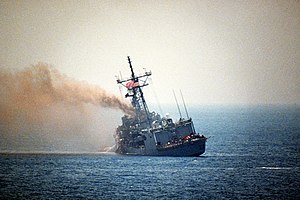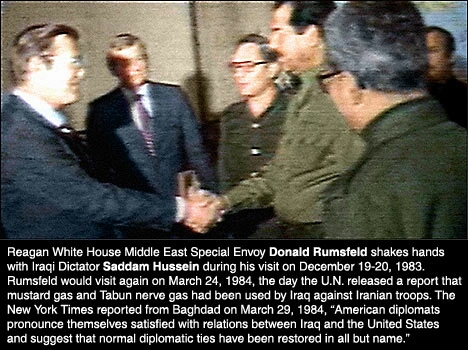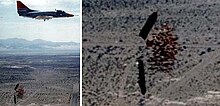Tags
David Carlson, Iran Air 655, Noam Chomsky, Praying Mantis, Reagan's Support for Saddam Hussein, The Iraqi attack on USS Stark, USS Vincennes, Will Rogers III



David Carlson was the commanding officer of the USS Sides which was operating in a supporting role in the vicinity of the USS Vincennes and closely monitoring the escalating situation when the Vincennes launched its heinous missile attack on Iran Air 655 on July 3, 1988, which killed all 290 passengers, 66 of them children.
Commander Carlson later wrote an account of what had transpired in the course of the missile attack on Iran Air 655. His account of the events leading to the missile attack on Iran Air 655 was given in his article “The Vincennes Incident” published in the September 1989 issue of the Proceedings of the U. S. Naval Institute.
Carlson criticizes the official apologetic for the downing of Iran Air 655 in terms of the appeal to mistakes made in the “fog of war”. He concludes that “View it as you will, Iran Air flight 655 was shot down for no good reason.”
Before we look at Carlson’s account of the sequence of events leading up to the missile attack on Iran 655 by the USS Vincennes, we must consider the relevant background episode, Operation Praying Mantis, which occurred in April 1988, a few months before the criminal downing of Iran Air 655, and the overall context of US attacks on Iranian oil platforms and naval assets in the Persian Gulf.
As Chomsky points out in his piece “Outrage“, the Reagan administration solidly backed the brutal Iraqi dictator Saddam Hussein in his criminal war of aggression against Iran.
Reagan removed Saddam from the terrorist list and showered him with military aid to enable his aggression against Iran. He also blocked congressional condemnations of Saddam’s crimes against the Kurds. Worse, under Reagan’s patronage, Saddam even got away with a missile attack on the USS Stark which killed 37 US sailors!

As Chomsky writes:
“It is worth remembering the extent of Washington’s devotion to its friend Saddam. Reagan removed him from the terrorist list so that aid could be sent to expedite his assault on Iran, and later denied his murderous crimes against the Kurds, blocking congressional condemnations. He also accorded Saddam a privilege otherwise granted only to Israel: there was no notable reaction when Iraq attacked the USS Stark with missiles, killing 37 crewmen, much like the case of the USS Liberty, attacked repeatedly by Israeli jets and torpedo ships in 1967, killing 34 crewmen.“

It is in the context of the Reagan administration’s increasing support for the brutal dictatorship of Saddam and his criminal aggression against Iran that we must understand the US military aggression Operation Praying Mantis against the Iranian navy and oil platforms in Iranian territorial waters in April 1988 and how it paved the way for the “trigger happy” mood aboard the USS Vincennes as it targeted and downed Iran Air 655.
As Commander Carlson put it:
“Who among us did not feel just a little cheated at having missed out on a chance to have been a part of Praying Mantis? I suspect that in the Vincennes these feelings ran very strong.”
However, we should note that the International Court of Justice ruled on November 6, 2003, that the US military aggression “Operation Praying Mantis” carried out against Iran in April 1988, and its predecessor “Operation Nimble Archer” in October 1987, “cannot be justified as measures necessary to protect the essential security interests of the United States of America.”
(Source: http://www.icj-cij.org/docket/files/90/9715.pdf)
This ICJ judgment implies that both military operations were acts of aggression against Iran and in flagrant violation of international law and norms of conduct governing the actions of States, but, unfortunately, these forms of aggression and violation of international law are consistent with the Mafia-style US policy and intervention in the region and elsewhere.
Operation Praying Mantis targeted Iranian oil platforms and the puny Iranian navy in Iranian territorial waters. Consistent with the US military record of tactics of savage overkill and destruction by overwhelming force, the much-vaunted and pathological “shock and awe” tactics, the Iranian Sassan oil platform was attacked with overwhelming military force on April 18, 1988.
The US aggression in Iranian territorial waters against the puny Iranian navy, and the Iranian oil platforms and their pitiful defense resources and personnel, was mounted jointly by several groups of warships, including the destroyers USS Merrill and USS Lynde McCormick, aircraft from the USS Enterprise and USS Truxtun, the LAMPS helicopter detachment from USS Samuel B. Roberts, the Marine Air Ground Task Force from the USS Trenton, the guided missile cruiser USS Wainwright, the guided missile armed destroyer USS Joseph Strauss, the frigates USS Simpson and USS Bagley, and Navy SEALS!!!
Operation Praying Mantis also successfully targeted the Iranian Sirri oil platform for destruction.
In response, Iranian Boghammer speedboats attacked a few ships in the Persian Gulf. The US dispatched A-6E Intruder aircraft which dropped Rockeye cluster bombs on the Iranian speedboats!
Rockeye cluster bombs are designed to destroy tanks! Each of them carry 247 bomblets! Again, savagery is the governing standard of these US military operations.

Operation Praying Mantis also targeted the Iranian combat craft Joshan and sank it. Two Iranian F-4 Phantom fighters which were orbiting 48 kms away from the scene were attacked by missiles launched by the USS Wainwright. One of them was badly damaged and the pilot landed his plane at Bandar Abbas airport, the same airport from which the doomed Iran Air 655 was to depart a few months later.
The Iranian frigate Sahand was attacked and sunk in Iranian territorial waters when it engaged with two Lizard A-6Es which were on combat patrol for USS Joseph Strauss.

Another Iranian frigate Sabalan also engaged several A-6Es in Iranian territorial waters. It was attacked with a Mark 82 laser-guided bomb which severely damaged and crippled the frigate.
At least 56 Iranians died defending themselves against the overwhelming aggression of Operation Praying Mantis. The only US casualties were two marines killed when their Sea Cobra helicopter gunship crashed in the Persian Gulf due to reasons unrelated to combat.
It is against this backdrop that Commander Carlson wants us to understand the aggressive and criminally negligent actions pertaining to Iran Air 655 taken aboard the guided missile cruiser USS Vincennes which was sent to the Persian Gulf to protect the frigate Samuel B. Roberts as it was hauled back to the US after hitting a mine. To quote him again:
“Who among us did not feel just a little cheated at having missed out on a chance to have been a part of Praying Mantis? I suspect that in the Vincennes these feelings ran very strong.
Having watched the performance of the Vincennes for a month before the incident (shooting down of Iran Air 655), my impression was clearly that an atmosphere of restraint was not her long suit. Her actions appeared to be consistently aggressive…”Robo Cruiser” was the unamusing nickname that someone jokingly came up with for her and it stuck.”
Carlson disputes the official story on the shooting down of Iran Air 655 on several points.
First, it was claimed that a few Iranian speedboats were intent on attacking the USS Vincennes and USS Elmer Montgomery.
Carlson points out the absurdity of supposing that the Iranian speedboats would do this given their knowledge of the overwhelming force used by the US navy in Operation Praying Mantis.
It was also claimed in the official story that the Iranian speedboats fired at the LAMPS III helicopter sent on patrol from the Vincennes. The helicopter did return safely to the Vincennes before the ship engaged in aggressive actions against the Iranian speedboats.
Carlson argues that the Vincennes helicopter was probably too close to the Iranian speedboats (We should remember that the Iranian speedboats were in their own territorial waters!) and that they were known to fire warning shots at helicopters to keep them away. He also points out that if the Iranian speedboats had intended to attack the Vincennes and Elmer Montgomery, they would not have fired warning shots at the helicopter and alerted the ships.
“Robo Cruiser” Vincennes used the warning shots fired at its helicopter by the Iranian speedboats as a pretext for attacking those speedboats. It was the Vincennes which first opened fire on the Iranian speedboats in Iranian territorial waters after her helicopter had come back safely.
According to the official story, both the Vincennes and Elmer Montgomery stopped engaging the Iranian speedboats when they ceased to pose a threat to the US ships, but Carlson points out that the Iranian speedboats never posed a threat to the ships even when the latter (Vincennes and Elmer Montgomery) closed the position of the small speedboats at high speed 50 minutes earlier.
Carlson also points out that the Vincennes was not acting in self-defense because it had asked for permission to shoot at the Iranian speedboats, permission that would not be necessary if the ship was acting in self-defense.
Carlson writes:
“The harder you look at it, the more absurd the concept seems that a few speedboats would be taking on the Vincennes and the Elmer Montgomery with any notion of success. In any event, they would surely not want to alert the Vincennes by shooting at the helicopter. I hold a minority view. The helicopter drew fire because it was a nuisance to the IRGC boats. The Vincennes saw an opportunity for action, and pressed hard for Commander Middle East Force to give permission to fire. Deescalation went out the window. Equipment failed. The “fog” rolled in…“
It is in this context that Carlson’s tactical action officer (TAO) informed him that radar track TN 4131 (referring to Iran Air 655) had been classified as an Iranian F-14 threat by the Vincennes.
Carlson writes that he followed standard procedures and “locked up and illuminated TN 4131 with our missile fire control radar.” But the aircraft continued climbing and was on a southwesterly course that would bring it directly over the location of the Vincennes.
Carlson assumed that the Vincennes had correctly identified track TN 4131 as an Iranian F-14. However, given its range and altitude, lack of antisurface warfare capability, and lack of radar emissions, Carlson says that he “evaluated the track as a nonthreat.”
Carlson also observes that “TN 4131 did not appear to react to the illumination with fire control radar, and this was most unusual.” Obviously, an F-14 fighter interceptor would react appropriately to such radar targeting.
At this point, the Vincennes, under the command of Captain Will Rogers III, announced that it would take down TN 4131 at 20 miles with its missiles.
Carlson says that he “wondered aloud with disbelief” at this announcement, but did not take the steps to dissuade the Vincennes from shooting down TN 4131. He had assumed that the Vincennes had the correct information to justify shooting the aircraft down.
Carlson later realized that “This was bad reasoning. TN 4131 was destroyed before I was made aware that it was not an F-14.”
According to Carlson, the salient facts in this situation were:
1. When the decision was made by Captain Will Rogers III to shoot down TN 4131, it was climbing, not descending or diving. If it was an Iranian F-14 intent on some surface (suicidal) action against a US missile cruiser, it would be descending or diving. (This should have given pause to any responsible Captain, but we are, after all, dealing with the Captain of “Robo Cruiser”!)
2. It was showing proper identification: IFF Mode III.
3. It was in the proper flight corridor for civilian aircraft going from Bandar Abbas to Dubai.
We should also consider in this context the relevant facts on Iran’s F-14 force.
The F-14 is a fighter interceptor and carries anti-aircraft missiles.The Imperial Iranian Air Force, under the Shah of Iran who wielded autocratic and brutal power as the monarch of Iran after a US and UK-backed coup d’état overthrew the democratically elected regime of Mosadeggh in August 1953, was offered the latest in American military technology by President Richard Nixon after his visit to Iran in 1972.
In 1974, the Shah of Iran placed an order for the purchase of dozens of F-14 aircraft and hundreds of Phoenix anti-aircraft missiles, all worth US $ 300 million.
Unlike the Dassault Mirage F1 Iraqi jet which attacked, during Saddam’s brutal war against Iran, the USS Stark in May 1987 and killed 37 US Navy personnel, the F-14 is a fighter interceptor and not capable of mounting any significant attack on surface targets, especially ships.
So, even if TN 4131 was likely to be an Iranian F-14, given the clear evidence that it was ascending and not descending or diving, the judgment that it posed a threat and should be shot down with missiles was a belligerent one and the missile attack an unjustified act of aggression.
Since the other salient facts, available to the crew of Vincennes at the time of the missile attack, showed that track TN 4131 was unlikely to be an F-14, and probably a civilian airliner, the decision to shoot it down without further assessment was an unpardonable act of criminal negligence, if not terrorism.
Commander Carlson has offered his explanation for the lethal action of the Vincennes against Iran Air 655 on July 3, 1988:
“My guess was that the crew of the Vincennes felt a need to prove the viability of Aegis (Aegis Combat System based on computer and radar technology and produced by Lockheed Martin) in the Persian Gulf, and that they hankered for an opportunity to show their stuff. This, I believe, was the climate that aided in generating the “fog”.”

In the annals of official US propaganda and history, it does not matter that this Rambo-style hankering to “show our stuff” cost the lives of 290 Iranians, 66 of them children.
It is also revealing that Carlson observes that “…despite the numerous articles written on the subject, not one request for information has come our way.”
And what about the Captain of “Robo Cruiser” responsible for the distinguished act of valor of shooting down a civilian airliner with 290 passengers, 66 of them children?
He remained in command of the Vincennes until May 27, 1989. In 1990, he was given the Legion of Merit award for “exceptionally meritorious conduct as commanding officer (of the Vincennes)” and for maintaining a “calm and professional atmosphere” during the missile attack on Iran Air 655, although the award citation did not make any reference to the atrocious incident.

The US government has never formally apologized to Iran for the downing of Iran Air 655 by its naval forces.
We can only stand in awe of such display of American exceptionalism!

“Pictured here, Newsweek covers for 12 September 1983 (left) and 18 July 1988 (right) that illustrate KAL and Iran Air incidents respectively. A full-page photo of the airplane with “Murder in the Air” (KAL incident) leaves little doubt in reader’s mind of who the culprits were, while “Why it Happened” (Iran Air incident) with no graphic presentation of the airplane is accompanied by questioning and soul-searching.” (Wikipedia)

Pingback: 'The Iranian Threat' - LiberalVoiceLiberalVoice — Your source for everything about liberals and progressives! — News and tweets about everything liberals and progressives
Pingback: Noam Chomsky: The Real ‘Grave Threat’ to World Peace Isn’t Iran—It’s the U.S. | Chicago Activism
Pingback: Noam Chomsky: Rogue states and nuclear dangers
Pingback: Noam Chomsky: The Real ‘Grave Threat’ to World Peace Isn’t Iran—It’s the U.S. | Radio Free
Pingback: 'The Iranian Threat': Who Is the Gravest Danger to World Peace? - Palestine Chronicle | Palestine Chronicle
Pingback: ‘The Iranian Threat': Who Is the Gravest Danger to World Peace? | Palestine.com
Pingback: Noam Chomsky: Why America Is the Gravest Threat to World Peace | Alternet -
Pingback: Noam Chomsky: Why America Is the Gravest Threat to World Peace « WORDVIRUS
Pingback: ‘The Iranian Threat': Who Is the Gravest Danger to World Peace? - Palestinian Community in the United Kingdom
Pingback: Noam Chomsky: Rogue States and Nuclear Dangers | Tales from Genie and Lou
Pingback: Noam Chomsky: “The Iranian Threat” - Guernica / A Magazine of Art & Politics
Pingback: Noam Chomsky, Rogue States and Nuclear Dangers | limitless life
Pingback: Who benefits from War? » স দা লা প
Pingback: The 4th Media » Noam Chomsky: The Real ‘Grave Threat’ to World Peace Isn’t Iran — IT’S THE US!
Pingback: Chomsky on Iran deal | Port O Call Publishing - Port Angeles News in Print & Online.
Pingback: TRANSCEND MEDIA SERVICE » “The Iranian Threat” – Who Is the Gravest Danger to World Peace?
Pingback: Noam Chomsky on the Iran Deal - The Voice Times
Pingback: “The Iranian Threat”: Who Is the Gravest Danger to World Peace? | The Global Realm
Pingback: Rogue States and Nuclear Dangers | SHOAH
Pingback: NOAM CHOMSKY / La ‘amenaza’ iraní | La Hora del Recuento
Pingback: Noam Chomsky: “The Iranian Threat” Who Is the Gravest Danger to World Peace? | Rise Up Times
Pingback: САЩ и Израел са най-голямата заплаха за световния мир – Ноам Чомски | РАДИО ЗВЕЗДА
Pingback: САЩ и Израел са най-голямата заплаха за световния мир – Ноам Чомски | РАДИО ЗВЕЗДА
Pingback: The Iranian Threat – by Noam Chomsky « Flexible Reality
Pingback: САЩ и Израел са най-голямата заплаха за световния мир – Ноам Чомски | Сливен ДНЕС и УТРЕ